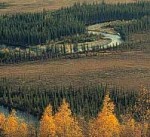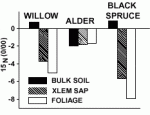Bonanza Creek LTER
by Knut Kielland, BNZ LTER
Additional investigators: Roger Ruess (PI), Rich Boone (PI), David Jones (Collaborator)
Graduate students: Jack McFarland, Nan Werdin, Trish Loomis, Rich Brenner, and Laura Hughes
The Bonanza Creek LTER biogeochemistry program includes several projects examining the role of dissolved organic N (DON) in forest ecosystems. The emphasis of these projects are 2-fold:
- What are the turnover characteristics and composition of DON in taiga forest soil
- What is the direct role of organic nitrogen in the N nutrition of these forests?
Taiga soils are dominated by organic soil N fractions, with correspondingly low concentrations of ammonium and nitrate. The makeup of the DON pool includes a sizeable fraction composed of free amino acids, which pool is approximately 5-fold greater than the ammonium pool.
The stable isotope signature of soils and plants show that species in high-fertility soils, such as alder, differ greatly from species such as willow and black spruce that grow in low-fertility soils. This divergence underscores the differences in N dynamics among these soils, and suggests variation of N sources across successional gradients.
Both laboratory and in situ field estimates of amino acid turnover suggest that this pool is very dynamic. For example, the flux of nitrogen through the amino acid pool in black spruce soils is over an order-of-magnitude greater than the rate of gross mineralization. Even in the earliest successional stage, the turnover rate of simple amino acids, such as aspartate, glutamate, and glycine, is on the order of less than 1 hour. From these results we suggest that the transformation of protein to amino acids and not amino acids to NH4+ is the major factor limiting N availability in these soils. As DON turnover constitutes a large proportion of the annual N flux in these forests, it warrants inclusion in models of climate change in high-latitude ecosystems.
Relevant literature
Kielland, K. 2001. Short-circuiting the nitrogen cycle: ecophysiological strategies of nitrogen uptake in plants from marginal environments. In: Plant Nutrient Acquisition - New Perspectives. Ae, N., J. Arihara, K. Okada, and A. Srinvasan (eds.), pg. 376-398 Springer-Verlag, Tokyo.
Jones, D.L. and K. Kielland. 2002. Soil amino acid turnover dominates the nitrogen flux in permafrost-dominated taiga forest soils. Soil Biol. Biochem. 34:209-219.

 Enlarge this image
Enlarge this image

